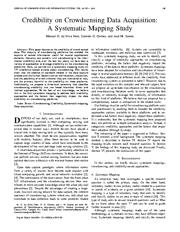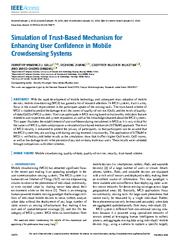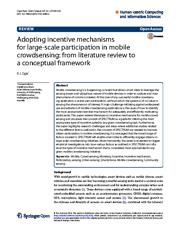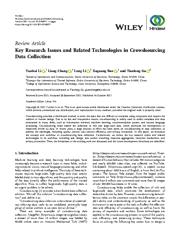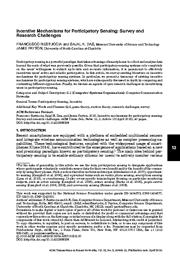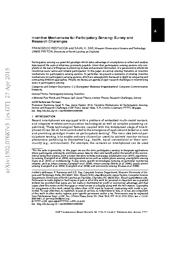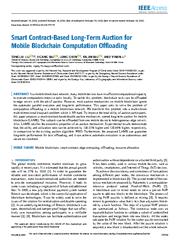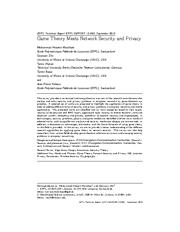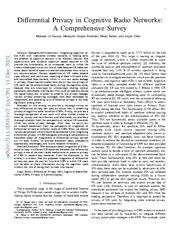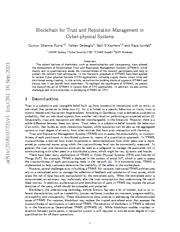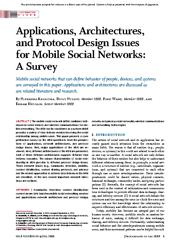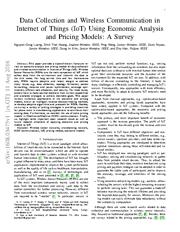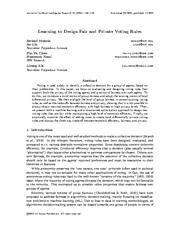A copy of this work was available on the public web and has been preserved in the Wayback Machine. The capture dates from 2020; you can also visit the original URL.
The file type is application/pdf.
Filters
Credibility on Crowdsensing Data Acquisition
2019
Journal of Communication and Information Systems
This paper focuses on the credibility of crowd sensed data. The ubiquity of crowdsensing platforms has enabled the capture of sensed information useful for several applications domains. ...
However, one concern with crowdsensing is the information credibility and, over the last few years, we have seen a variety of approaches to leverage credibility on the crowdsensing platforms. ...
[200] introduced a privacy-aware crowdsensing design with truth discovery. ...
doi:10.14209/jcis.2019.26
fatcat:o4cja467jbgenap4akpxmcu3ym
Simulation Of Trust-Based Mechanism For Enhancing User Confidence In Mobile Crowdsensing Systems
2020
IEEE Access
This paper illustrates the establishment of user confidence during recruitment in MCS as it is very critical for the success of MCS systems and proposes a simulation trust-based mechanism (SiTBaM) approach ...
For more information, see http://creativecommons.org/licenses/by/4.0/ VOLUME 8, 2020 ...
These incentives can take various forms i.e. presence/location-aware, behavioural-aware, flat incentive, mobility-aware, and mixed incentive [14] . ...
doi:10.1109/access.2020.2968797
fatcat:kegfiusr2bcudifqh2vze4bbd4
Adopting incentive mechanisms for large-scale participation in mobile crowdsensing: from literature review to a conceptual framework
2016
Human-Centric Computing and Information Sciences
The phenomenal growth in the richness and diversity of sensors on smart devices [3], combined with the inherent ...
environment and for understanding complex urban and community dynamics [1] . ...
This issue of location-based privacy is mostly addressed by mechanisms based on k-anonymity [53] . ...
doi:10.1186/s13673-016-0080-3
fatcat:euypyllcvncvbpnnulyxghncfq
Key Research Issues and Related Technologies in Crowdsourcing Data Collection
2021
Wireless Communications and Mobile Computing
Furthermore, we review the key research topics and related technologies in its workflow, including task design, task-worker matching, response aggregation, incentive mechanism, and privacy protection. ...
In recent years, a large amount of effort has been spent on crowdsourcing in data collection, to address the challenges, including quality control, cost control, efficiency, and privacy protection. ...
response aggregation data, (4) incentive mechanism design, and (5) privacy-preserving. ...
doi:10.1155/2021/8745897
fatcat:vobajfz7i5bnnpfvx6vo2kzmxa
Incentive Mechanisms for Participatory Sensing
2016
ACM transactions on sensor networks
In this article, we survey existing literature on incentive mechanisms for participatory sensing systems. ...
In particular, we present a taxonomy of existing incentive mechanisms for participatory sensing systems, which are subsequently discussed in depth by comparing and contrasting different approaches. ...
framework for vehicle-based
crowdsourcing
×
×
Kawajiri et al. [2014]
Gamification-based mechanism
×
×
Li and Cao [2014]
Two privacy-preserving incentive mechanisms
×
Li and Cao [2013]
Privacy-aware ...
doi:10.1145/2888398
fatcat:bsixa53xebdkdbmedqt77cxsie
Incentive Mechanisms for Participatory Sensing: Survey and Research Challenges
[article]
2015
arXiv
pre-print
In this paper, we survey existing literature on incentive mechanisms for participatory sensing systems. ...
In particular, we present a taxonomy of existing incentive mechanisms for participatory sensing systems, which are subsequently discussed in depth by comparing and contrasting different approaches. ...
For the online case, the authors design a near-optimal truthful mechanism with an online task allocation algorithm that achieves a constant competitive ratio of θ( 1 /2). ...
arXiv:1502.07687v3
fatcat:ykgrtdt3vnez5hiht463viu7wa
Applications of Economic and Pricing Models for Wireless Network Security: A Survey
[article]
2017
arXiv
pre-print
Unlike wireline networks, the broadcast nature and the highly dynamic change of network environments pose a number of nontrivial challenges to security design in wireless networks. ...
This paper provides a comprehensive literature review on applications of economic and pricing theory to security issues in wireless networks. ...
k-anonymous location
privacy, truthfulness,
balanced budget, and
satisfaction ratio
improvement
Market
equilibrium
CN
[129]
Double
auction
Phone
users
Phone
users
Spectrum
Buyers' ...
arXiv:1707.07846v1
fatcat:xb3jvolwmjad7oxdefdd2pq7dq
Smart Contract-Based Long-term Auction for Mobile Blockchain Computation Offloading
2020
IEEE Access
However, most auction mechanisms on mobile blockchain ignore the automatic parallel execution and long-term performance. ...
The subtasks can be offloaded from one mobile device to heterogeneous edge servers. Also, LAMB satisfies the economic properties of an auction mechanism. ...
Furthermore, it also describes the design of smart contracts. Section IV describes the incentive mechanism. ...
doi:10.1109/access.2020.2974750
fatcat:pyatcsomkrbvtlihnvcq7ntvre
Game theory meets network security and privacy
2013
ACM Computing Surveys
In each category, security problems, players, and game models are identified and the main results of selected works, such as equilibrium analysis and security mechanism designs are summarized. ...
The presented works are classified into six main categories based on their topics: security of the physical and MAC layers, application layer security in mobile networks, intrusion detection systems, anonymity ...
Furthermore, mechanism design [Nisan and Ronen 1999; Nisan 2007] has enabled researchers to design security and privacy mechanisms based on the analytical results obtained. ...
doi:10.1145/2480741.2480742
fatcat:55ixmohvijaelflxqrrbtnvfuu
Differential Privacy in Cognitive Radio Networks: A Comprehensive Survey
[article]
2021
arXiv
pre-print
(PII), such as location, device ID, signal status, etc. ...
In order to preserve this privacy leakage, various privacy preserving strategies have been developed by researchers, and according to us differential privacy is the most significant among them. ...
[12] proposed the use of anonymization techniques such as k-anonymity to preserve privacy of CR users. ...
arXiv:2111.02011v2
fatcat:a5hique4fvfxrclslvpgda5jyy
Blockchain for Trust and Reputation Management in Cyber-physical Systems
[article]
2021
arXiv
pre-print
In addition, we also outline challenges and future directions in developing DTRMS for CPS. ...
In addition, the authors also introduced an algorithm, called Anonymous Proof of Location (A-PoL), to anonymously prove user's location. ...
A TRMS can work on a single context or multiple-context awareness in deriving trust from collected evidence depending on its initial design [4] . ...
arXiv:2109.07721v1
fatcat:qw27quabmrebnint776yye2cwe
Applications, Architectures, and Protocol Design Issues for Mobile Social Networks: A Survey
2011
Proceedings of the IEEE
KEYWORDS | Community detection; content distribution; context-aware data transfer; mobile social networking services and applications; network architecture and protocol design; security and privacy; social ...
This paper presents a comprehensive survey on the MSN specifically from the perspectives of applications, network architectures, and protocol design issues. ...
Simply hiding certain information such as message content and sender information provides the incentive for the selfish nodes to remain truthful in the network. ...
doi:10.1109/jproc.2011.2169033
fatcat:qqrflfnnxnho5f7odt726lkykm
A Survey on Human-Centric Communications in Non-Cooperative Wireless Relay Networks
2018
IEEE Communications Surveys and Tutorials
node detection and defense systems, and (4) incentive mechanisms. ...
In this paper, we present an in-depth survey on human-centric communication challenges and solutions in the non-cooperative WRNs that focuses on: (1) an overview of the non-cooperative WRNs and introduction ...
The authors are grateful to the anonymous reviewers for their constructive comments and suggestions to improve the quality of the article. ...
doi:10.1109/comst.2018.2791428
fatcat:2v6odowj4rhx5ico7g2i4pk6ne
Data Collection and Wireless Communication in Internet of Things (IoT) Using Economic Analysis and Pricing Models: A Survey
[article]
2016
arXiv
pre-print
This paper provides a state-of-the-art literature review on economic analysis and pricing models for data collection and wireless communication in Internet of Things (IoT). ...
Besides, we survey a variety of pricing strategies in providing incentives for phone users in crowdsensing applications to contribute their sensing data. ...
This indicates that incentive mechanisms are very important in privacy-aware participatory sensing systems. ...
arXiv:1608.03475v1
fatcat:2jjbf3bw2vai5kqi74r56dviwe
Learning to Design Fair and Private Voting Rules
2022
The Journal of Artificial Intelligence Research
Voting is used widely to identify a collective decision for a group of agents, based on their preferences. ...
In this paper, we focus on evaluating and designing voting rules that support both the privacy of the voting agents and a notion of fairness over such agents. ...
Acknowledgments The authors are grateful to Michael Hind for discussions and the reviewers for their insightful comments and suggestions. ...
doi:10.1613/jair.1.13734
fatcat:wfx7auizlfdmlcjydisrzwy6om
« Previous
Showing results 1 — 15 out of 1,544 results

